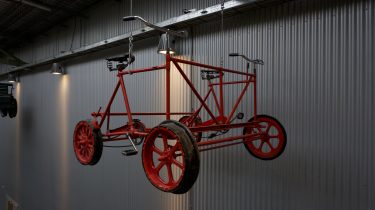



Type: H.L. II
Looking at this draisine, it’s easy to see that the manufacturer, Simplex, was an experienced bicycle-making company: due to the saddle seats, handlebars and shape of the frame, this type of draisine was appropriately called a ‘rail-cycle’. The handlebars were meant only as a place to rest your arms. Because the rail-cycle was ridden only on the tracks, there was no need to actually steer with the handlebars.
Its simple construction made this rail-cycle extremely lightweight, so that it was easy to lift when needed and took little effort to set in motion. The disadvantages were that there was no room to take any equipment along and that the supervisor had to pedal for themselves. Still, multiple versions of the rail-cycle remained in widespread use until at least the 1930s.
Simplex was founded in Utrecht in 1887 as a machine factory. From 1892, they began to make bicycles as well. Five years later, the company moved to Amsterdam, where it also began to manufacture draisines. These draisines were a popular product with not only the ‘major’ railways but also among narrow-gauge lines, such as those on plantations in what was then the colony of the Dutch East Indies (now Indonesia). Simplex ceased to exist as an independent company shortly after World War II. First, there was a merger with bicycle manufacturer Locomotief. Then, in 1968, the brand was acquired by Gazelle.


